Best Resume Format: 3 Examples & Templates
A great resume is your golden ticket to attracting hiring managers. It's not just about listing your skills and experiences - it's formatting your resume in a way that highlights your most important experiences.
In this blog post, we'll explore the factors that make your resume stand out. We'll zero in on the best resume format that works for everyone, regardless of the position you're applying for.
- Best Resume Format: Guidelines to Follow
- Understanding the Core Elements of a Best Resume Format
- Three Resume Formats for Your Next Interview
- Modern Resume Template
- Professional Resume Template
- Simple Resume Template
- Types of Resumes
- Adapting Your Resume for Applicant Tracking Systems (ATS)
- Addressing Special Cases in Resume Formatting
- Conclusion
- FAQs
Best Resume Format: Guidelines to Follow
When crafting a standout resume, paying attention to resume formatting guidelines is crucial. The layout and design principles you employ can greatly impact the overall impression your resume creates.
Aiming for a clear, professional look for your resume is vital. This includes emphasising important sections like contact info, work experience, skills, and education.
The right typography can really lift the readability and overall appeal of your resume formats. Sticking to traditional fonts such as Arial, Calibri, or Times New Roman in a legible size (10-12 points) is a good call.
Consider using bullet points for a breezier read. They break down the info into easy-to-scan chunks, helping recruiters quickly understand your qualifications.
Lastly, pay attention to consistency. Uniform formatting, such as font styles, spacing and alignment, adds a polished, professional touch to your resume.
All these elements help to create the best resume layout to impress hiring managers.
Understanding the Core Elements of a Best Resume Format

The best resume format communicates your qualifications to make a memorable impression on potential employers.
Here's how to format your resume :
Start with the basics: your contact information. This includes your full name, phone number, email address, and professional social media profiles, if applicable. You'll want to pop these into your resume headings.
Then, consider including a sharp, concise summary or objective statement. This gives a quick glimpse of your skills, experience, and career aspirations. Your work experience section is vital, showcasing your relevant accomplishments and responsibilities.
To further strengthen your resume, create a dedicated skills section. This puts the spotlight on your key strengths and proficiencies.
Also, include your educational background. Make a list of where and when you graduated. You can also mention any side courses, workshops, and certifications you've completed throughout the years.
Three Resume Formats for Your Next Interview
Maintaining a functional resume format not only benefits you; it also makes the job of the hiring manager easier. Let's look at three different resume styles that suit different career stages and industries.
First up is the "Simple" template. It's clean and clear, perfect for people in many different fields.
Next, we have the "Modern Resume" template. If you're in a creative field, this one's for you. It's got a unique layout to show off your artistic skills and projects.
Finally, there's the "Professional" template. It's great for people with lots of experience and leadership skills.
By picking the template that matches your career and industry, you can ensure your qualifications shine. That way, you can stand out from the crowd.
Here are three resume layout examples . Use these resume layout examples to create your resume:
Modern Resume Template
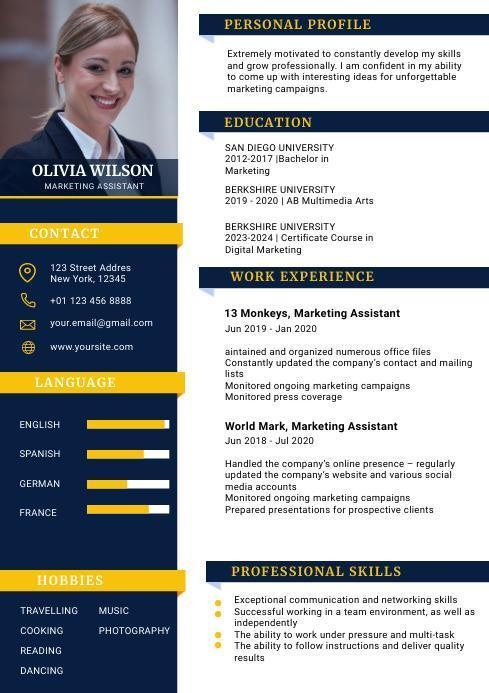
Source: Postermywall
Understanding a Modern Resume Template
Modern resume templates bring a fresher and simpler approach to your job application. They showcase your skills, experience, and personality in a more modern way.
Design Features
Modern resume templates have bold typography, clean lines, and white space. They're easy to read and grab attention. Some might also have extra colours, icons, or graphics to add visual interest.
When to Use a Modern Resume
A modern resume template can be great for:
Applying in Industries That Value Trends: Tech, marketing, or design industries often like to see modern resumes. They show that you're up to date and can adapt to new things.
Creative Fields or Startups: These companies often like fresh, innovative thinking. A modern resume can align well with the company culture.
Standing Out: If you want to make a lasting first impression, a modern resume can help. Its unique design can make you stand out.
Key Parts of a Modern Resume
A modern resume has a few key parts:
Personal Branding Statement: A quick, strong statement about your unique value can really set the tone.
Infographics: Some modern resumes use progress bars, charts, or graphs to show off your skills or achievements.
Social Media Handles: In today's world, showing your professional social media accounts can show you're active and engaged in your field.
With a modern resume template, you can create a standout resume that will catch a hiring manager's eye.
Professional Resume Template
Here is a sample resume format for a professional resume:
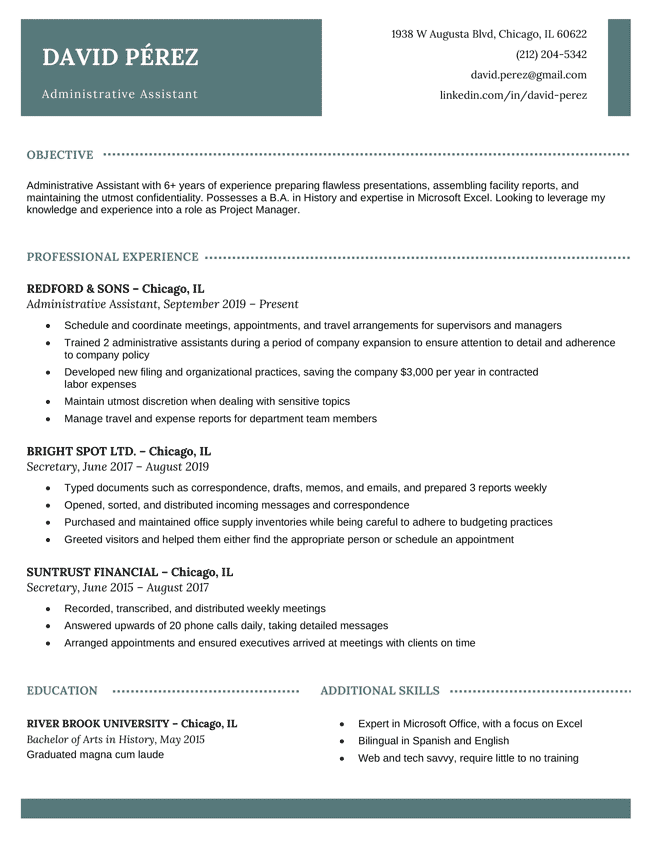
Source: resumegenius
Understanding a Professional Resume Template
Professional resume templates are all about showcasing your skills, qualifications, and experience in a polished and formal way.
They're designed to show off your professionalism and expertise and are versatile enough for many industries and career levels.
Design Features
These types of templates are neat and organised, with traditional fonts and conservative colour schemes. They're easy to read and don't have too many distracting design elements. The template will often have clear sections and subheadings to make it easy to navigate.
When to Use a Professional Resume
A professional resume template can be perfect for:
Applying in Corporate Industries: Finance, law, or healthcare often appreciate a formal, professional resume.
Showing a Long, Consistent Career: A professional resume can highlight these effectively if you've had many roles and achievements in your field.
Highlighting Strong Professional Background: If you have plenty of professional experience, this resume can showcase your expertise and skills.
Key Parts of a Professional Resume
A professional resume often includes the following:
Work History: This is where you'll list your past positions, job titles, companies, and dates. It helps employers see your career progression and achievements.
Skills Section: Here, you'll list relevant skills, like technical abilities, industry knowledge, and essential soft skills.
Professional Affiliations: This is where you can add any memberships or certifications. It shows your commitment to your field and professional development.
Using a professional resume template, you can create a comprehensive, appropriate resume to help you stand out in traditional or corporate environments.
Simple Resume Template
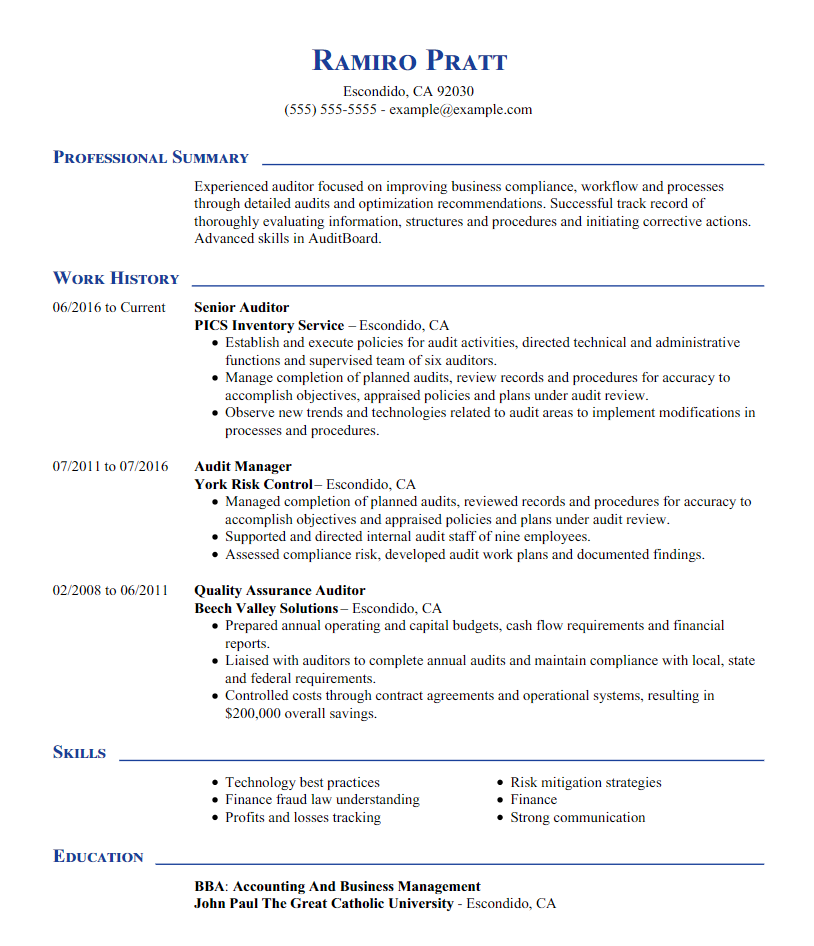
Source: myperfectresume
Understanding a Simple Resume Template
A simple resume template is all about keeping things clear and straightforward. It presents your skills and qualifications directly and clearly. It works for many situations and career stages.
Features and Design Elements
A simple resume has a clean design with an easy-to-read font. It doesn't have too many fancy design parts, just straightforward information. It may use sections with clear headings and bullet points to make it easy to scan.
When to Use a Simple Resume
Here are some situations where a simple resume works best:
1. When You're New to the Job Market: A simple resume is a good choice if you're fresh out of school or looking for your first job. It keeps focus on your potential and vital qualities.
2. When You Have Limited Work Experience: If you have little work experience or gaps in your work history, a simple resume helps highlight your skills and qualifications.
3. When Clarity is Key: If you want hiring managers to quickly understand your qualifications, a simple resume can help by focusing on clarity and readability.
Essential Elements of a Simple Resume
A simple resume usually includes the following:
1. A Clear Objective: Start your resume with a short statement that explains your career goals or the job you want. This helps employers understand what you're looking for.
2. A List of Relevant Skills: Include a section that shows your critical skills that match the job you're applying for. This makes it easy for employers to see if you're a good fit.
3. Short Work or Volunteer Experience: Briefly describe your past work or volunteer experience. Highlight what you achieved, what you were responsible for, and what skills you gained.
A simple resume template with these critical parts can help you make a strong impression on hiring managers. This is especially true when they value simplicity and clarity.
Types of Resumes
There are different resume formats, each with its own structure and purpose.
The chronological resume format works well for people with a steady work history.
The functional resume format is all about skills and abilities. This works well for those who want to highlight their skills or if they have gaps in their work history.
The combination resume format blends both types - chronological and functional. It provides a complete view of skills, work experience, and achievements.
Some resumes are specific to certain industries.
Knowing these different types of resumes can help job seekers better present their skills and qualifications and help them stand out to potential employers.
Each of the resume formats below with an accompanying resume format sample.
Chronological Resume Format
Ideal Scenarios for a Chronological Resume
A chronological resume best fits people with a steady work history and a clear career path.
It's beneficial if you want to put a spotlight on your experience and show you've been reliable in your field. Many industries prefer this traditional way of showing your career story.
Pros and Cons
The big plus of the chronological resume format is how straightforward it is. Employers can quickly see your career path, job titles, and how long you've worked. This format also shows off your most recent and relevant work first.
But, it can highlight if you've had breaks in work or lots of job changes, which can be hard to explain.
Sample Chronological Resume

Source: hloom
Functional Resume Format
Perfect Situations for a Functional Resume
A functional resume format is great for people who want to focus on their skills and abilities, not their work history.
It's handy for changing careers if you're just starting or have had breaks in work. This format lets you show off relevant skills and wins, making it easy for employers to see your potential.
Pros and Cons
The vital advantage of a functional resume format is it lets you put focus on your skills and wins. This is especially useful if you don't have a lot of work experience.
It lets you highlight your strengths that match the job you want. But, it doesn't give a clear timeline of your work history, which some employers may prefer. Also, ensuring your resume fits each job you apply for may take more work.
Sample Functional Resume
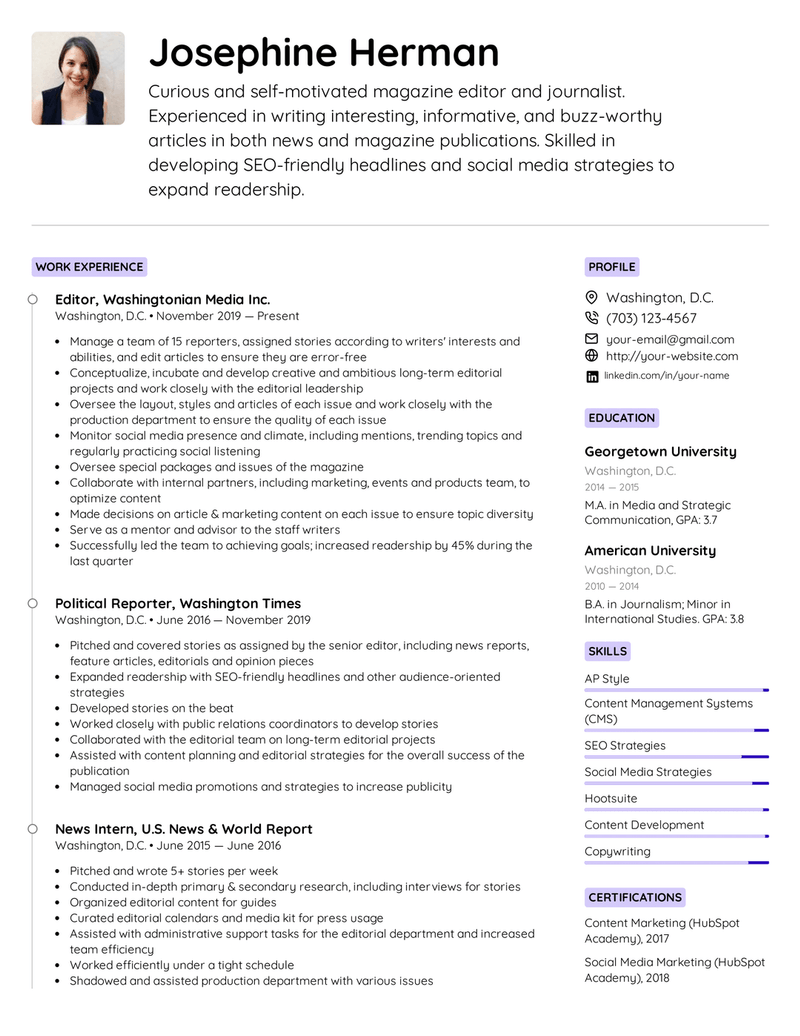
Source: MyEasyResume.io
Combination Resume Format
Situations Where a Combination Resume Works Best
The combination resume format is perfect for people who want to show off their skills and work experience.
It's a good fit if you have solid skills and want to show how your career story backs this up.
It's a valuable format for those looking to move up, change fields, or return to work after a break.
Pros and Cons
The great thing about the combination resume format is it lets you highlight both your skills and work experience, giving a complete picture of your qualifications.
It lets you show off your skills and how you've used them in different jobs. But, it can take careful planning and customising to ensure your resume fits each job you apply for.
Also, there may be better choices if you're new to work or want to downplay some jobs.
Sample Combination Resume
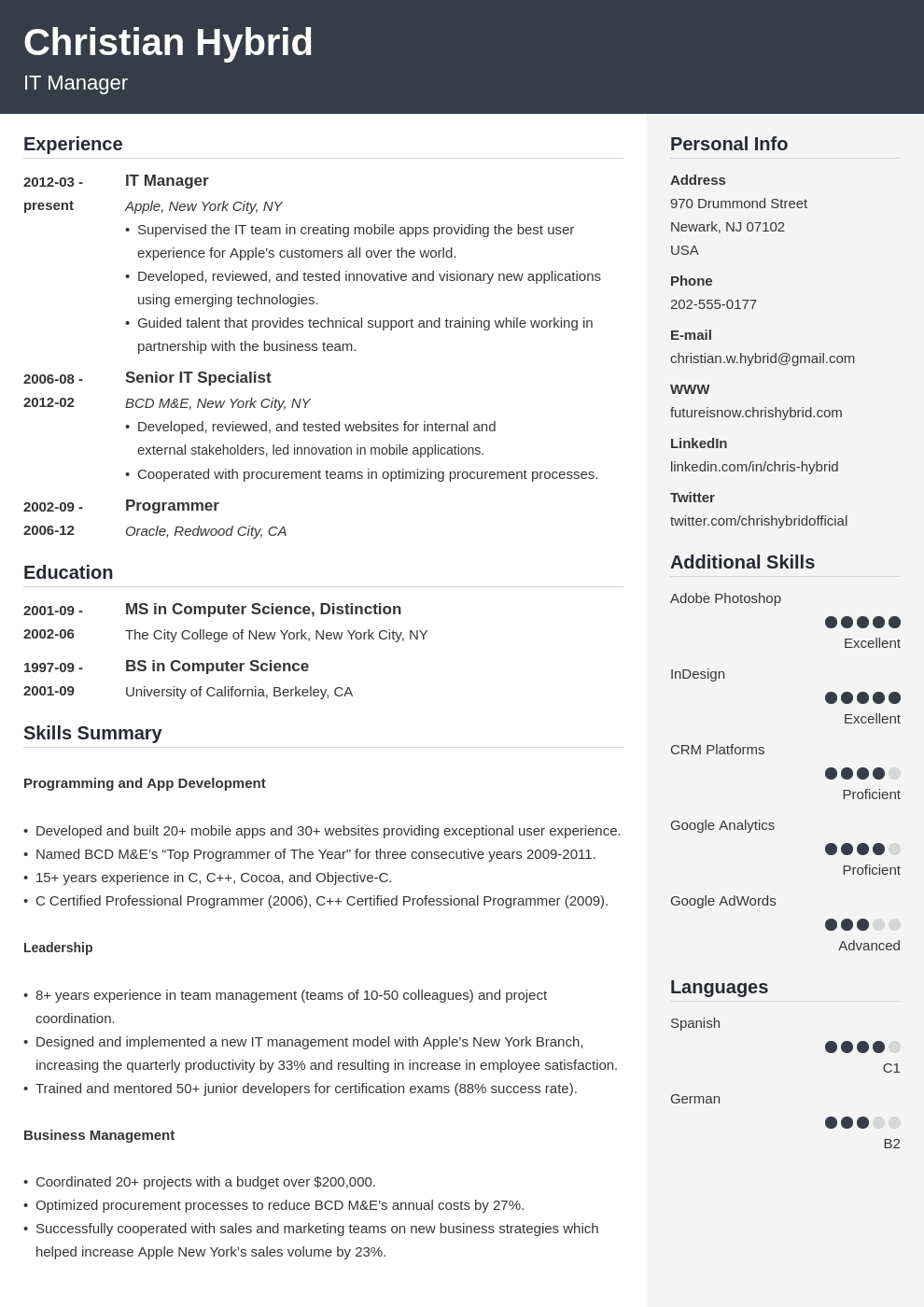
Source: zety
Targeted Resume Format
Instances to Use a Targeted Resume
A targeted resume format works best when you're applying for specific jobs or fields with clear requirements. This format lets you customise your resume to match the job description, putting the spotlight on the most relevant qualifications and experience. It's a good choice in a tough job market where being precise and customising your resume can help you stand out.
Pros and Cons
The most significant advantage of a targeted resume format is it lets you show off the most relevant skills and experiences that match the job you want.
This format lets you show how well-suited you are for a specific job, boosting your chances of getting an interview. But, making a targeted resume for each job takes time and requires careful attention. Also, it depends on your ability to understand and match the needs of each job post.
Sample Targeted Resume
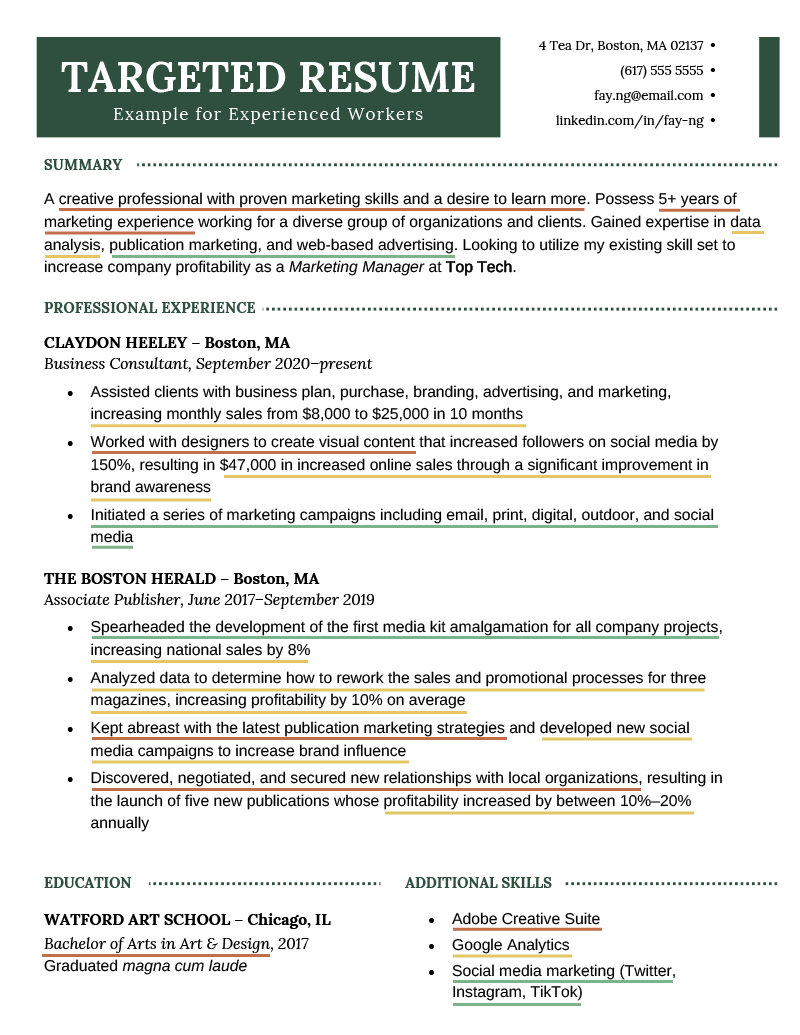
Source: resumegenius
Adapting Your Resume for Applicant Tracking Systems (ATS)
Understanding ATS and Its Importance
Applicant Tracking Systems (ATS) are software used by employers to manage and filter large volumes of resumes. ATS systems scan resumes for specific keywords, work experience, and qualifications to identify the most suitable candidates. It is crucial to adapt your resume to be ATS-friendly as it increases the chances of your resume being selected for further review by human recruiters.
Guidelines for Creating an ATS-Friendly Resume
To create an ATS-friendly resume, it is essential to follow certain guidelines. Use standard fonts, avoid complex formatting, and stick to basic bullet points. Incorporate relevant keywords from the job description throughout your resume, ensuring they are seamlessly integrated. Use clear section headings and organise information logically. Additionally, it is crucial to save and submit your resume in a compatible file format, such as PDF or Microsoft Word.
Example of an ATS-Optimised Resume
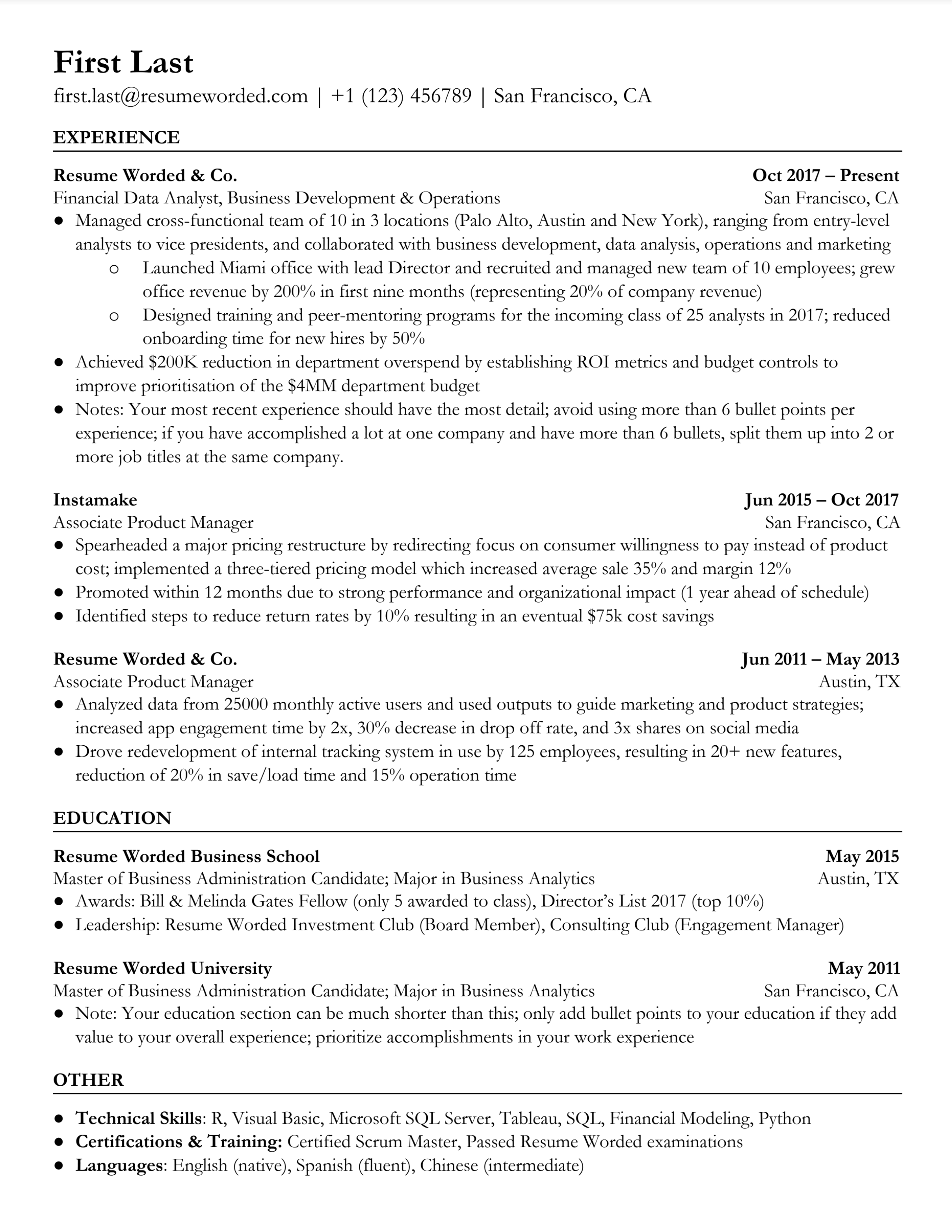
Source: ResumeWorded.com
Addressing Special Cases in Resume Formatting
Regarding special situations in resume formatting, it's vital to tweak your resume to meet specific needs.
Dealing with Gap Years
If you need to explain gap years in your resume, highlight any relevant things you did during that time, like freelance work, volunteering, or extra education/training.
Show off the skills you picked up during the gap, and focus on showing how you adapted and grew during that time.
Navigating a Career Switch
When making a career change, put the spotlight on skills that you can carry over and highlight experiences that show you can do well in the new field. Make sure your resume fits the needs of the job you want, put the focus on relevant wins and show how your skills match the new industry.
Formatting a Resume with No Work Experience
If you don't have job experience, concentrate on your education, internships, related studies, volunteering, and outside activities. Make sure to show projects or achievements that prove you have skills for the job you're after.
For example, if you want to apply for a project management position, you can include in your resume a project you did in college that showcased outstanding results.
Use a functional or combo resume to focus on your strengths and potential, not just past jobs.
By handling these unique situations, you can present your qualifications in a way that underscores your strengths for different situations.
Conclusion
In summary, picking the best resume format is vital for showing off your skills and qualifications to employers.
The chronological resume is best for those with steady work history, while the functional resume format highlights your skills and abilities. While there are no standard resume formatting rules, you can use the sample resume formats we shared to guide you. You can also use an online resume builder if you're having a hard time creating your own.
Frequently Asked Questions (FAQs)
- What is the best resume format for my experience level?
The best resume format depends on your experience level and specific circumstances. For individuals with a consistent work history, the chronological format is often suitable. If you have limited work experience or employment gaps, the functional or combination format may be more effective.
- How do I know if my resume is too long or too short?
Ideally, a resume should be concise and focused. It should highlight your qualifications without overwhelming the reader. Generally, a one-page resume is recommended for entry-level or early career professionals, while those with more experience may opt for a two-page resume if necessary.
- Should I include a photo on my resume?
Usually, you don't need or want a photo on your resume, unless the employer asks for one or if you're applying for roles in the entertainment or modelling industry.
- How do I make my resume stand out from the competition?
Concentrate on your unique qualifications, wins, and related skills to make your resume different. Use clear examples and numbers to show your influence. Ensure your resume fits each job, includes keywords from the job ad, and has a tidy and professional look.
- Can I use a non-traditional resume format?
Yes, you can use a non-traditional resume format. Non-traditional formats include infographic resumes, video resumes, portfolio resumes, social media resumes, skills-based resumes, and personal website resumes. If you are looking for a creative resume template or you want to know the good and bad formats, you can check here
- How do I tailor my resume to a specific job posting?
To make your resume fit a specific job ad, read the job ad closely and spot the main skills and experiences needed. Adjust your resume to include those keywords and to show off relevant wins that prove you're the right fit for the job.
- What should I include in my skills section?
In your skills section, include a mix of hard skills (specific technical abilities) and soft skills (interpersonal and transferable qualities). Focus on skills that are relevant to the job you are applying for and back them up with examples or achievements where possible.
- Does a functional resume format work if I have gaps in my work history?
If you've had periods without work, a functional resume format is right for you. A functional resume format focuses on your skills, accomplishments, and abilities rather than the chronological order of your work history. This format is ideal for you if you have employment gaps, are changing careers, or have limited experience in your current field.
- Should I include references on my resume?
It is generally not necessary to include references on your resume. Instead, create a separate document with a list of references and have it ready upon request. Make sure to inform and seek permission from your references before including them.
- How do I know if my resume is ATS-friendly?
To ensure your resume works with ATS, stick to simple fonts, avoid fancy formatting, and use regular bullet points. Include important keywords from the job ad in your resume and save it in a file format like PDF or Microsoft Word that ATS can read. You can also use ATS-friendly resume templates you find online.
